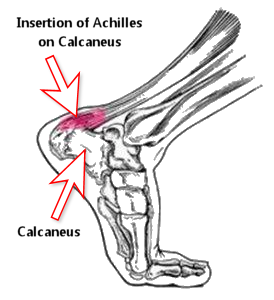Sever’s disease (Calcaneal Epophysitis) is an inflammatory condition of the growth plate in the heel bone (calcaneus). It is the most common cause of heel pain amongst children, generally affecting active young males aged between 10 and 14, and females between 8 and 11. The pain in the back of the heels can be quite debilitating, particularly for young athletes. How many times have we seen children, or your child, limp off the soccer-football pitch?
A little background info on Sever’s Disease
 Young children’s feet are composed mostly of cartilage. As a child grows, bone slowly replaces this cartilage, starting from the centre of the bone and working its way to the extremities until there is no more cartilage left to replace. This process is called ossification. Soon after, the ends also start to develop bone. These two areas of developing bone have a strip of cartilage between them. This is called the growth plate, which allows the bone to grow bigger. Slowly, as bone grows from each direction, the growth plate thins out, eventually disappearing as the bone becomes fully-grown.
Young children’s feet are composed mostly of cartilage. As a child grows, bone slowly replaces this cartilage, starting from the centre of the bone and working its way to the extremities until there is no more cartilage left to replace. This process is called ossification. Soon after, the ends also start to develop bone. These two areas of developing bone have a strip of cartilage between them. This is called the growth plate, which allows the bone to grow bigger. Slowly, as bone grows from each direction, the growth plate thins out, eventually disappearing as the bone becomes fully-grown.
So what causes it?
Sever’s Disease (Calcaneal Apophysitis) occurs when the growth plate at the back of the heel becomes inflamed due to the pull of the Achilles tendon on the heel. The Achilles tendon attaches to the back of the heel at the site of the heel’s growth plate, and when it lifts the heel up, it pulls on the growth plate with great force.
When this pull occurs too often or with too much force (such as during activities like running or jumping), the growth plate at the back of the heel becomes inflamed and painful.
In most cases, this pain is experienced on one side only, and isolated to the back of the heel where the Achilles tendon attaches. And often the pain only occurs during forceful activities. The affected area is usually sensitive to touch and pressure. And depending on the severity of the condition, there may or may not be swelling or redness over this area.
Why does it affect some children and not others?
Children who play particular sports that involve running and jumping, which can place excessive stresses upon the relatively soft heel growth plate, are at a higher risk.
Also, some children’s bones lengthen faster than their muscles and tendons which can result in their muscles and tendons become comparatively tighter as the bone lengthens, which places further tension on the soft growth plate.
How is it diagnosed?
Since Sever’s disease is an inflammatory condition, the most effective diagnostic tool is a bone scan which will detect any increase in blood flow where the Achilles tendon meets the heel bone. But as with all foot problems, Anthony will also do a full visual diagnosis to identify any other areas of concern that may be exacerbating the problem. For example, a pronated (rolled-in) foot tends to increase Achilles tendon tension so treating the pronation can be an essential part of treating Severs.
What treatments are available?
Ideally, limiting the stretch of the Achilles tendon would be the most effective treatment for Severs. But we know that limiting children’s activities is almost impossible (you know what kids are like!)
So Anthony has implemented a successful treatment program for young and upcoming athletes with Sever’s disease, combining the use of corrective foot orthotics with massage therapy.
This personalised treatment program has helped sustain the athletic longevity of many young athletes who have attended his clinic with heel pain, foot and posture problems.
In fact, a study of 85 children with Sever’s disease treated with orthotics and stretching showed that all patients improved and were able to return to their sport of choice 2 months after the diagnosis. There were only two recurrences. (Micheli and Ireland.1987. J Ped. Orth, 7 (1): 3)

